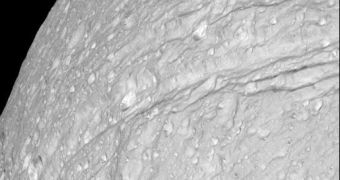What is now a massive ball of ice around Saturn, the moon Tethys had an ocean at some point in its past, say researchers at the University of California present at a major science conference in Houston. Tethys is only one of the 60 or so natural satellites orbiting around Saturn, has a medium size and an average density close to that of pure water ice in normal atmospheric conditions.
The theory that it might have had an ocean under its surface is suggested by a massive rift on its surface, probably created by the action of heated liquid rising towards the surface. Considering the size of the moon and that of Saturn, researchers argue that the heat could have only been produced by tidal heating, immediately followed by a cooling process.
Erinna Chen, one of the researchers at University of California participating in the study says that the Ithaca Chasma rift formation can only be accounted for through gravitational interactions with Saturn and possibly another moon, Dione. These would have altered the orbit of Tethys into a more eccentric one which determined a increased heating process of Tethys' interior through frictional heating.
However, at some point in time, Dione stopped interacting gravitationally with Tethys, allowing it to fall back into its regular orbit and begin to cool. The ocean under its surface eventually froze and expanded, thus applying stress on the surface to create the Ithaca Chasma rift. "We have a large rift system that brought water to the surface, so it seems likely that this happened," said Chen.
It is yet unknown how deep the ocean would have been, if such an entity even existed, but they approximate it could have easily reached about 100 kilometers in depth. Tethys might in fact still have an ocean under its surface even today, joining the group of moons in the solar system with possible oceans, such as Europa and Callisto, two of Jupiter's moons. Another contender for the group is another of Saturn's moons, Enceladus, which seems to have water rising to the surface from its interior, however whether it has an ocean of water still remains unknown.

 14 DAY TRIAL //
14 DAY TRIAL //